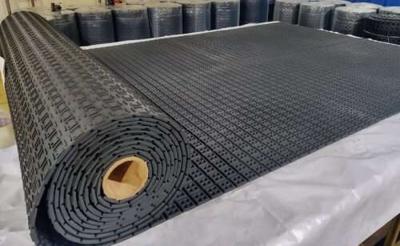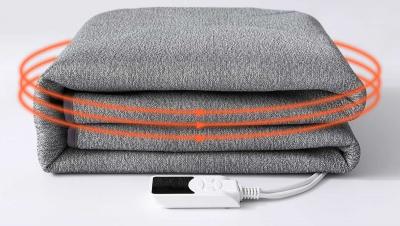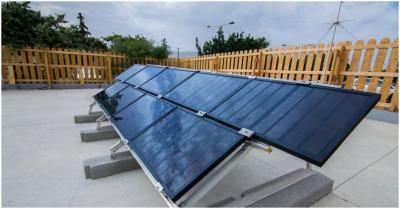The Graphene-Info newsletter, October 2020
Published: Tue, 11/03/20
SpaceBlue launches graphene-enhanced flooring product called SpaceMat
SpaceBlue, a UK-based start-up company, has launched SpaceMat, a graphene-enhanced flooring product, planned to be the first of a range of products aimed at reducing wastage from vehicle tires, supported by the Graphene Engineering Innovation Center's (GEIC) ERDF Bridging the Gap program at The University of Manchester. The SpaceMat uses graphene to improve the performance of recycled tire rubber compared to previous efforts.
Dr. Vivek Koncherry’s company SpaceBlue has developed graphene-enhanced recycled rubber products for mass-market applications. The SpaceMat product is constructed from 80% waste tire material and 20% graphene-enhanced natural rubber. The graphene reportedly more than doubles the compressive strength of the rubber, in turn increasing the durability of the mat. Using graphene, it is possible to engineer the mechanical performance of the recycled material, bringing it close to the performance of a virgin polymer system.
Having launched SpaceMat to market, Vivek is now developing a series of products, including traffic cones and anti-viral doormats, and is looking for partners to license and promote the technology globally.
Xiaomi launches a graphene-based smart heating mattress
Xiaomi recently launched a crowdfunding campaign for its new graphene-based smart heating mattress. The graphene layer in the mattress is used to generate heat, and according to the company the graphene enables uniform heating without the overheating or overcooling problems that are inherent in traditional heating mattresses.
Xiaomi offers two kinds of graphene blankets - a single mattress at 299 Yuan (about $43) and a double one at 499 Yuan (about $73). The crowdfunding campaign has already attracted over 3,500 supporters and raised over 1.5 million Yuan.
MSI uses graphene composite in its graphic cards for improved durability and heat transfer
MSI, a global computer hardware manufacturer, has revealed that it is utilizing graphene composites in its RTX 3000 series GPUs. It seems that the graphene composite parts are replacing the backplate, traditionally made of plastic, and provide greater heat dissipation performance and better stiffness to handle the weight of the entire card while still weighing less than plastics.
It was said that the use of graphene is needed to leverage the increasingly powerful GPUs within each generational leap while providing reinforced durability and conductivity to make sure that the cards work hard and stay intact for a long period of use.
Graphene-perovskite solar farm trial up and running in Greece
An experimental graphene-based perovskite solar farm has been operating in Greece for several months, and early results are said to be very promising when it comes to power output and efficiency.
Located at the Hellenic Mediterranean University in Crete and spearheaded by the EU’s Graphene Flagship, the new solar farm consists of nine graphene–perovskite panels with a total area of 4.5m2 and a total output of approximately 261 watt-peak (Wp). Each graphene-perovskite module incorporates graphene and related 2D materials such as molybdenum disulfide, which helps to significantly increase the device’s performance and stability. The active layer of the panels is a mixed triple cation lead halide perovskite.
Emmanuel Kymakis, Professor at the Department of Electrical & Computer Engineering of the Hellenic Mediterranean University (HMU), Vice-President of the HMU Research Center and Director of the interinstitutional Post-Graduate Program “Nanotechnology for Energy Applications”, stated that the solar panels have been in continuous operation since June. A full year of operation will be needed before all the results can be shared, but Kymakis reported that the ‘preliminary results are very promising’. He said graphene–perovskite photovoltaics (G-PE PVs) exhibit superior performance to conventional PV panels at high temperature conditions, and when it comes to stability only a small amount of degradation was observed after three months.
What's new at Manchester University's GEIC? James Baker, CEO, gives us an update
In December 2018, Manchester University’s Graphene Engineering Innovation Center (GEIC) first opened, aiming to accelerate the commercial impact of graphene and help realize its potential to revolutionize many sectors.
James Baker, the CEO at Graphene@Manchester (G@M) who's responsible for the development and delivery of the business strategy which includes the National Graphene Institute (NGI) and the GEIC, kindly agreed to answer a few questions we had and update us on the latest from the GEIC.
Graphene-Info updates all its graphene market report
New versions of all our graphene market reports, updated to July 2020, are now available. Graphene-Info provides comprehensive market reports focused on specific areas of graphene research and industry.
Among these reports are: The Graphene Batteries Market Report, The Graphene Supercapacitors Market Report, The Graphene Oxide Market Report, The Graphene for the Display and Lighting Industries Report and The Graphene Investment Guide.
Spain-based Gnanomat recently announced the launch of its graphene-based nanocomposites.
A collaborative initiative launched the first nanomaterial-enabled all polymer solar thermal cell.
Nanotech Energy has launched Nanotech EMI Armor Paint & Sheets, graphene powered coatings and films for electromagnetic interference (EMI) and radio frequency interference (RFI) shielding, as well as heat management.
Talga Resources has provided an update on the commercial progress of its graphene-enhanced silicon anode lithium-ion battery product Talnode-Si.
The Graphene Flagship has been invited by the European Commission to create an experimental pilot line for graphene-based electronics, optoelectronics and sensors.
Directa Plus recently signed a non-binding memorandum of understanding with NexTech Batteries, a company active in the field of lithium sulphur batteries based in Nevada, US.
Rice University's process to produce pristine graphene in bulk from waste (dubbed “flash graphene”) was recently modified for recycling plastic.
Australian Advanced Materials has announced it is developing a graphene-oxide-based ink battery that is able to self-charge within minutes.
An international team of researchers recently reported its success in creating a new type of graphene-based photodetector.
Researchers from The University of Manchester have developed a new graphene-based testing system for disease-related antibodies, initially targeting a kidney disease called Membranous Nephropathy.
Researchers from the Daegu Gyeongbuk Institute of Science and Technology in South Korea have developed a low-cost energy storage device to power electronic devices like wearable skin sensors.
Nano Graphene (AKA GrapheneCA) has announced that it is adding a new antimicrobial product to protect glass surfaces in public and private places from dangerous microorganisms.
Caltech researchers have developed a new type of multiplexed test with a low-cost sensor that may enable the at-home diagnosis of a COVID infection.
Do you have a friend or a colleague that might be interested in Graphene technology? Forward this mail to update him on the world of Graphene.
If you received this email from a friend, subscribe to this newsletter here!





